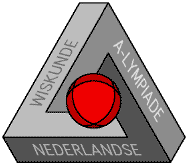 Math A-lympiad:
Final 1996-1997
Math A-lympiad:
Final 1996-1997 Math A-lympiad:
Final 1996-1997
Math A-lympiad:
Final 1996-1997In deciding on the new route for the motorway, there will be a weigh of a lot of poorly comparable criteria. One of these criteria is of course a fast junction. Other demands are about thee distance to civilised area's: not too far away because of industry and economical potency, but not too close either, because of noise pollution, saving nature (nature area's? natural sceneries?), the ground on which the motorway will run (sand, clay), the limitation of the number of necessary "pieces of art" like flyovers (if another junction is intersected) and bridges, expropriation-costs, and short access-routes from the places along the proposed route to the motorway. Also the amount in which this new route relieves the traffic on other routes, could play a role. For you the task to execute a preparatory study, that will play an important role in the decision-making. Write a solid report on the preparatory study, in which at least the following matters arise:
GOOD LUCK!